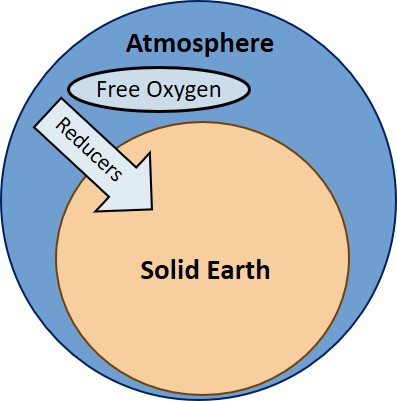
Explore 3.19 Oxygenating Earth
Learning Objectives
By the time you have completed the 3.19. Introduction & Exploration Activities, you should be able to:
- Describe the development of Earth’s atmospheric oxygen in terms of states and transitions.
- Briefly describe the oxygen content & basic character of Earth’s atmosphere during the following stages/states: 1) The early to mid-Precambrian, 2) The mid to late Precambrian (‘boring billion’), and 3) The latest Precambrian to present (modern).
- Briefly describe what produced these transitions in atmospheric oxygen levels: A) Mid-Precambrian rise in oxygen (early to ‘boring billion’) and B) Late Precambrian rise in oxygen (‘boring billion’ to modern’).
- Identify the cause of climate cooling (and the production of the first ‘snowball Earth’ event) that accompanied the mid Precambrian (first) oxidation event.
Earth’s Oxygen Transitions
In this exploration, we deepen our understanding of the processes and events that produced the atmospheric oxygen states and transitions that lead to our modern, breathable atmosphere.
First, review Earth’s timeline.
Characterize Earth’s early atmosphere—Hadean through mid-Precambrian—by 1) listing prominent atmospheric gases, 2) the amount of oxygen, and 3) the types of organisms that thrived during that state. Number each answer.
Characterize Earth’s atmosphere during the ‘boring billion’—mid- to late-Precambrian—by 1) listing prominent atmospheric gases, 2) the amount of oxygen, and 3) the types of organisms that thrived during that state. Number each answer.
Characterize Earth’s modern atmosphere—late-Precambrian to present—by 1) listing prominent atmospheric gases, 2) the amount of oxygen, and 3) the types of organisms that thrived during that state. Number each answer.
Based on the relative strength of methane and carbon dioxide, describe what would happen to the greenhouse effect and the temperature of a planet’s surface if abundant atmospheric methane were converted by to carbon dioxide.
So, what is the source that continuously replenishes Earth’s atmospheric free oxygen (O2)?
Using our bank account analogy, imagine that the amount of money you are depositing doesn’t change. In this case, how could you increase the balance of your account?
Can you translate the analogy to Earth’s atmosphere? Recall that oxygen deposits to the atmosphere result from oxygen-producing photosynthesis which, after the rise of cyanobacteria, remained approximately constant. Recall also that withdrawals from the atmosphere result from reaction with the reduced iron, sulfur, and carbon—which were abundant on early Earth. Briefly describe what is required, besides the production of oxygen (by photosynthesis), for oxygen to build up in the atmosphere.
Based on what you learned above, what would happen to the rate of carbon burial if there were abundant coastlines, increased sediment load by rivers, and thriving microorganisms?
What could cause the abundance of coastlines to increase? Also, what could cause the abundance of sediments in rivers to increase?
How would skyrocketing rates of unreacted carbon burial affect oxygen levels?
Which atmospheric greenhouse gas absorbs more heat—methane or carbon dioxide?
How did the burial of dead organisms affect the concentration of oxygen in the atmosphere?
Study the ‘Complex Cells Emerge’ section of The Earth Timeline and answer this question: When did the first eukaryotic cells—like those that comprise your body—arise?
What happened to the abundance of shorelines as the supercontinent Rodinia broke apart?
Where did cyanobacteria proliferate as Rodinia broke up?
What carbon-bearing atmospheric compound do cyanobacteria use to make food (hydrocarbons)?
When they use carbon dioxide and water to make hydrocarbons, what gas do cyanobacteria release into the atmosphere?
At the same time that cyanobacteria were proliferating in the newly formed nearshore environments produced as Rodinia broke up, abundant sediments were being shed off continents. What did the combination of abundant cyanobacteria and deposition in nearshore environments produce?
As proliferating cyanobacteria removed CO2 from the atmosphere and then were efficiently buried, CO2 was transferred from the atmosphere to solid Earth (through the hydrosphere & biosphere). How did this change the greenhouse effect and Earth’s climate?
How did this same process (moving carbon from atmosphere to solid Earth through the hydrosphere & cyanobacteria) affect the concentration of free oxygen (O2) in the atmosphere?
What impact did this increase in oxygen have on the biosphere?
Based on what you know about the previous events that caused atmospheric free-oxygen to increase, what would you predict caused oxygen to increase during the late Paleozoic?
What effect, would you predict, did transferring vast quantities of carbon from the atmosphere to solid Earth have on Earth’s climate?
Can you also predict what caused the late Paleozoic ice age to end?
Climate Cooling
So, what happened to the greenhouse effect of Earth’s atmosphere and to Earth’s surface temperature as methane was converted to carbon dioxide by the oxygen that cyanobacteria were producing?
Based on the processes we described above and on the description in The Earth Timeline, how did Earth escape this first Snowball Earth event?
Watch this video (4.5 minutes) to understand the patterns between CO2 and Earth's heating and cooling cycles.

